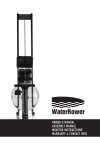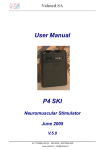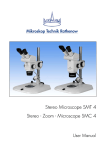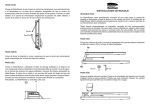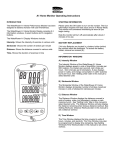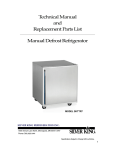Download WaterRower GX Owner`s manual
Transcript
Owner’s Manual assembly INSTRUCTIONS monitor instructions warranty & contact info OWNER’S MANUAL TABLE OF CONTENTS INTRODUCTION Owner’s Manual02 – 08 Assembly Instructions10 – 16 Monitor Instructions17 – 20 Warranty Information / Troubleshooting 21 – 22 Congratulations on becoming a WaterRower owner. Rowing is universally recognized as the perfect aerobic exercise − smooth, low impact, rhythmic and whole-body − unrivalled for its physiological benefits and aesthetic pleasures. “Rowing, indoors or outdoors, at any exercise level of intensity, requires a greater exercise expenditure than any other aerobic activity. Calories are burned in relation to the number of muscles used and the intensity and duration of the exercise. Rowing with a sliding seat uses a very large muscle mass since the upper, lower and trunk muscles are used vigorously.” -Dr. C Everett Koop- Former US Surgeon General While most rowing machines imitate the action of rowing, they do so mechanically, and therefore lack the natural dynamics experienced when a boat and crew glide down a river. At WaterRower, we have focused on replicating the physical dynamics of rowing, with the knowledge that this will achieve all of its physiological benefits, as well as much of the aesthetic pleasure. To maximize the enjoyment from using your WaterRower we recommend that you follow our suggestions on rowing technique and training programs. We hope that some of the discussion points in this manual will improve your knowledge about exercise in general, so that you are better able to fulfill your specific exercise objectives. Your WaterRower has been carefully hand-crafted to give you years of trouble-free use. You will notice that each WaterRower is unique due to the variance in color and grain that occurs naturally in genuine hardwood. We recommend that you closely follow the assembly details provided, particularly by assembling the machine in the correct sequence, and adhering to the suggested maintenance schedule. We hope you enjoy using your WaterRower for many years to come. 01 02 Safety We recommend consulting a physician before starting out with an exercise program. Please read all instructions before using the WaterRower. Additional information on getting started, rowing technique and rowing training advice can be found at www.HowToRow.com. ! Warning: Please keep hands away from moving parts when rowing machine is in use. For further information on safety tips, please refer to www.waterrower.com/safety. Operation The WaterRower is unique in using the effect of drag to provide an exercise which is entirely self paced. Because drag is linked to speed, a crew rowing down a river chooses its intensity of exercise simply by altering the pace at which they row: the faster the boat travels the greater the drag and the harder the crew must work. There is a similar effect in swimming. By replicating these dynamics the WaterRower does not require adjustment to increase resistance: if a more intensive workout is required, simply row faster and harder, and the WaterRower will respond accordingly. Water Level The amount of water in the Tank simulates the weight of the Boat and Crew as it glides down the river. Changing the Water Level does not change the resistance, it simply changes the mass which the user is trying to move. Increasing the Water Level simulates a heavier boat and crew mass, similarly reducing the Water Level simulates a lighter boat and crew mass. The Water Level is adjusted according to one’s personal preference or user type; the intensity is altered simply by moving the chosen mass faster or slower. A level gauge is positioned on the side of the the tank. Overfilling the tank could impact the warranty coverage. Do not fill above the maximum level. NOTE - Fill the tank with ordinary municipal water. Municipal water contains additives which will deter the growth of algae. If municipal water is unavailable, use distilled water. Unless using blue dye, add the purification tablet supplied with your WaterRower. (Refer to the section on Preventative Maintenance for advice on Water Treatment). Footpad Position The Footpad has been designed to be adjusted for maximum comfort. The Footstrap is designed to cross the foot at the pivot point of the toes (the ball of the foot). This should enable the heel to be raised off the Footboard as the user comes forward with each stroke. The Footpad can be easily adjusted 03 to accommodate different users, simply lift the top lip of the Footpad to unhook and slide up or down to reposition on another hole. Start up Maintenance During the first weeks of use, the wood in your WaterRower will adjust to the temperature and humidity of the environment. During this period it is strongly advised that you GENTLY tighten all the Connecting Bolts with the Allen Key. Please be careful not to overtighten any of these bolts. Additionally, as the Drive and Recoil Belts loosen up with use, it may be necessary to tighten the Recoil Belt. To do this, leave the Handle in the full forward position and adjust the Bungee/Recoil Belt Buckle to provide a little more tension. Please refer to ‘Adjusting the Recoil’ video at: www.waterrowerservice.com/videos. Preventative Maintenance Periodic maintenance is required to maintain the condition of the water in the tank. We strongly advise using Municipal Tap Water which contains other Chemicals to keep it free from Bacteria and Algae, etc. The water must be refreshed periodically by adding a Water Purification Tablet provided. The purification tablet degrades by exposure to light: this may vary from 6 months in direct sunlight to 2 years in an artificially lit environment. On average, add one purification tablet every 6 months. If water discoloration occurs add a purification tablet immediately. If the water does not clear, we recommend emptying the Tank, flushing it out with clean water, refilling, and adding a purification tablet. Never use Pool Chlorine or Chlorine Bleach in the Tank as this will irreparably damage the Polycarbonate Tank. The use of an alternative purification option in the tank beyond the approved WaterRower product could void the warranty. Maintaining and Cleaning To maintain the appearance and integrity of your WaterRower it is necessary to keep the machine clean. It is particularly important to ensure that there is no dust build up in the Clutch and Belt Mechanism between the Top and Bottom Decks. Dust can be removed by using a vacuum cleaner. The surface and groove in the monorail must be kept clean to prevent dust fouling the Seat Wheels, and can be cleaned by wiping with a damp cloth. The surface of the tank can be cleaned, however, please ensure you read the instructions for any cleaning fluids prior to use. do not use methylated spirits, chlorates, bleach or ammonia based fluids when cleaning any part of your WaterRower. The use of improper cleaning products could void the warranty. 04 Maintaining the Wood The natural wood WaterRowers are finished with Danish Oil which gives a deep penetrating finish to the Hardwood Frame. Other than occasional dusting or polishing, the wood requires no maintenance. The use and/or storage of the WaterRower in inclement weather, including but not limited, to extreme temperatures and moisture could void the warranty. Please visit www.HowToRow.com to learn more about the phases and positions of the rowing technique. Your Exercise Program Storage of Your WaterRower Your WaterRower can be stored upright. Lift the Rear Leg end, pull the WaterRower towards you and use the momentum to stand it in an upright position. When storing the WaterRower, please ensure the seat is in the forward position (close to the footboard). When stored upright the WaterRower is stable and it only takes the space of a chair. Starting Out With Rowing Rowing is an endurance sport which requires a high level of skill. This skill is based on the co-ordination of the legs (which create the driving force of the rowing action), torso and arms in propelling the boat across the water. The rowing action is comprised of both fast (drive phase) and slow (recovery phase) movements. Skill is also required in combining these movements into a rhythm in order to create a smooth, flowing, unhurried rowing action. The diagrams below show 3 basic movements of the rowing action. CATCH POSITION Sitting tall, arms straight reaching forward, shoulders relaxed, head up, eyes looking forward, legs compressed and shins vertical. DRIVE PHASE Drive back with the legs, arms hang off the handle and only begin to bend once handle is above the knees, torso is strong with good posture and body angle opens up slowly as you drive the legs. RELEASE POSITION Legs straight, handle drawn to chest, sitting back just past the vertical, torso firm, shoulders relaxed, head up and eyes looking forward. 05 Allow yourself the first few rowing sessions to practice the correct positions and phases as well as the correct ratio and rhythm of the rowing action. With regular rowing, the technique will become easier and you will soon experience the physiological benefits of rowing. Most of us recognize the benefit of exercise and the potential improvements to our general health and well being. However few of us fully understand the physiology of exercise and the best means of achieving our specific exercise objectives. In order to get the most out of any exercise program, it is essential to have an understanding of what your exercise objectives are. These may include reducing or maintaining weight, improving general strength, developing bulging muscles, improving sporting competitiveness or simply avoiding the health consequences of a modern sedentary lifestyle. It is important to set a few different types of objectives. These are divided into: ▪▪Immediate Objectives - weekly ▪▪Short Term Objectives - monthly ▪▪Long Term Objectives - yearly Your long term objectives are your final objectives, to achieve these, you need stepping stones which are the short term objectives and immediate objectives. Objectives need to be: ▪▪Specific - set goals that you would like to achieve by certain dates ▪▪Realistic - do not set a standard too high or motivation will be lost ▪▪Flexible - be prepared for set backs such as injuries and illness Your personal exercise objectives will influence the intensity, duration, frequency and type of exercise you do. Below are a few examples of different exercise objectives: Weight Maintenance At lower intensities our body uses a mixture of fat and carbohydrate as its source of fuel. As the maximum aerobic output is approached, the percentage of fat consumed as fuel reduces to zero. Also, as the duration of exercise is increased the percentage of fat consumed tends to increase. If your objective is weight maintenance, then it is necessary to burn as much fat (as opposed to carbohydrate) as the source of fuel as possible. This is best achieved at lower intensities and over longer durations. As soon as the intensity is increased the aerobic process starts to burn more carbohydrate and less fat. A low intensity (60 - 70% of the maximum heart rate) is typically that at which you can hold a conversation: it is by no means strenuous and is about that achieved by a brisk walk. 06 Aerobic Training A sustained exercise program will improve the efficiency with which the respiratory and cardiovascular system can supply oxygen. This improves lung function, heart function, vascular efficiency and capillary growth, leading to improved well being and endurance. At about 70 - 80% of the maximum heart rate, lactate begins to accumulate in the blood supply at a greater rate than it can be extracted by the liver, kidneys and other organs. Exercising above this intensity will cause progressive accumulation of lactate in the blood, increased heart and breathing rates and cause muscle fatigue. Prolonged exercise at or below this intensity will maintain lactate at nonfatiguing levels and exercise duration will be limited solely to the depletion of available fuel stores. If your exercise objective is aerobic (cardio-vascular/endurance) training then it is necessary to exercise at an intensity which will avoid fatigue due to lactate build up. This is best achieved at moderate levels of intensity over medium/long durations. A moderate exercise intensity (70-80% of the maximum heart rate) is about that achieved by a steady jog, avoiding the onset of muscle soreness. Training Guidelines To ensure you get the maximum benefit from training on your WaterRower and to avoid unnecessary problems or injuries here are a few guidelines: ▪▪A health check before starting an exercise program. ▪▪Use heart rate to monitor your intensity. ▪▪Always warm up and cool down. ▪▪Always stretch, especially at the end of your workout. ▪▪Keep a record of your workouts. ▪▪Keep well hydrated. ▪▪Gradually increase the intensity, duration and frequency of your workouts. ▪▪Ensure you include recovery time in your training program. ▪▪Add variety to your workouts (refer to www.HowToRow.com/workouts). Training Resources For further information on your exercise objectives and rowing training types please visit www.HowToRow.com. Anaerobic Training Anaerobic training causes the build-up of lactate (as rapidly as one minute after exercise is commenced). Lactate saturation will necessitate either a rapid reduction in exercise intensity or complete cessation. The accumulation of lactate limits the contribution of the anaerobic process to total energy production. Though energy may be generated rapidly, total work capacity and total output is limited. The level of intensity at which lactate begins to accumulate can be altered by training. This is best done by improving the efficiency of the aerobic process and is achieved by training at moderate levels of intensity. Training anaerobically is done at high intensities (80-100% of the maximum heart rate) over a short period of time (10 seconds to a few minutes). Interval training is a form of anaerobic training. 07 08 ASSEmBLY MANUAL We have done our best to keep the assembly instructions as clear and concise as possible. Assembling your WaterRower takes about 30-45 minutes and the only tool you need is a 5mm Allen Key that is included on the rear spacer or in the assembly bag. The WaterRower comes partially assembled in two boxes. Please Read Instructions Fully Before Starting Assembly Components Main Parts A Mono Rail Assembly (with seat and bungee) A B Tank Assembly C Sub Rails × 2 B C D Other Parts D Footboard E JCB (WRB-B700) × 8 F JCN (WRP-B711) × 8 G Handle Rest (WRP-P430) × 2 H Handle Rest Bolt (WRP-P455) × 2 I Clamp Bar Bolt (WRP-P1140) × 1 J Rail Sub Bracket Bolt (WRP-S201) × 1 K* Back of Footboard Bolt (WRP-B720) × 4 L E F G H I J K L M N O P Rail Sub Bracket (WRP-R1500) × 1 M 5mm Allen Key (WRP-B740) × 1 N Footpads (WRP-P1700) × 2 O Syphon Pump (WRP-B405) × 1 P Purification Tablets (WRP-B960) × 3 *K Bolts are located on the back of footboard [see step 3] 09 10 Step 1 Lay the sub rails on the floor with ends parallel. Dolly wheels on the outside. Attach the end of the mono rail to the angled ends of the sub rails with the Allen key (M) and 4 pairs of the JCN nuts (F) and JCB bolts (E) . Do not tighten all the way. E F ×4 ×4 Step 3 First remove the Back of Footboard Bolts (K) from behind the footboard. These bolts are used in steps 6 and 8. Place the footboard on the rails, then attach the sensor cable to the monitor cable protruding from the back of the footboard. The sensor cable may be taped to the back of the footboard. If so, remove the tape. Feed the cable gently through the brackets so it does not get trapped between the footboard and tank assembly. Align gold rivnuts on the tank assembly with the footboard’s handle rest holes. K It may be necessary to slightly loosen the 2 bolts on the top deck to allow the footboard clearance. Step 2 Place the tank assembly on the sub rails in the direction shown in the picture below. Using the Allen key (M) and 4 pairs JCN nuts (F) and JCB bolts (E), attach the forward riser bracket to the rails. You may need to apply slight pressure to align bracket and rail holes. Do not tighten all the way. E F 11 ×4 Step 4 Using the 5mm Allen key (M), screw the handle rests and bolts (G & H) through the top of the footboard into the rivnuts mentioned in the previous step. Do not over tighten these bolts. *If you loosened the Top Deck Bolts in step 3 to align the footboard, first tighten them before tightening the handle bolts. G ×2 H ×2 ×4 12 Step 5 Tighten the footboard to the mono rail by screwing in the clamp bar bolt (I). Do not tighten all the way. I ×1 Step 8 Screw in the rail sub bracket (L) underneath the footboard using the two remaining back of footboard bolts (K). Tighten all the way. J K ×1 ×2 Step 6 Stand the machine up. Insert 2 of the Back of Footboard Bolts (which were removed in step 3) into the footboard bracket and tighten. Having kept all the bolts loose will allow easier alignment of the bolts and rivnut holes in the footboard. Do not tighten all the way. K ×2 Step 9 Go back and tighten all the bolts in steps 1, 2, 5, and 6. Also tighten the 4 bolts on the front of the rower (below forward riser bumpers, see tag). Leave the bolts in step 4 and 7 alone. Should you experience any problem with aligning the components, loosen all bolts, align and retighten. Step 10 Tighten the rail sub bracket bolt (J) (Step 7) firmly in place. Step 7 Insert the sub bracket bolt (J) through the “U” in the rail sub bracket (L) into the rail, to hold the bracket in place for step 8. 13 14 Step 11 Unwrap the recoil belt from the forward riser bracket, making sure the belt runs below and around the pulley. Attach the D ring on the recoil belt to the bungee hook. How to Fill and Empty the Tank 1) To pump water, turn the knob clockwise to close valve as shown in figure A 2) Locate water source above (higher than) water destination: ▪▪See Figure B for filling tank ▪▪See Figure C for emptying tank 3) Squeeze pump 4-5 times until water flows 4) Turn knob counter-clockwise to allow air into the pump and end syphon. A Step 12 B The Level Gauge Lay the unit flat and remove the tank stopper from between the top and bottom deck. Use the included syphon pump (O) to fill the tank to the level indicated on the level gauge sticker located on the underside of the tank. (See next page.) The Level Gauge is positioned underneath the tank; to locate the Level Gauge sticker stand the machine up and look between the two wooden sub rails. Do not fill above the 19 level mark. Information on the sticker includes the Serial Number, WaterRower contact information and the Water Level Gauge. The standard Calibration Level is Level 17. The maximum level to fill the tank is Level 19 - DO NOT fill above this level. Doing so could void your warranty. Insert one purification tablet (P) every six months. Additional purification tablets are available upon request at: www.waterrowerservice.com/puritabs Moisten the tank stopper to assist with replacement. O C P It is recommended that all machines in a group class setting are filled to Level 17, this is to ensure all users are in the ‘same boat’, and race times remain accurate and consistent. WaterRower 560 Metacom Avenue Warren, RI 02885 1-800-582-2210 www.waterrower.com LEVEL GAUGE 19 MA XIMUM LEVEL 18 C A L IB R AT I O N 17 LEVEL 16 Recommended Water Level is Level 17 15 15 14 16 Monitor manual SETTING UP THE RACE PACE COACH DISTANCE RACE Introduction The WaterRower GX Monitor has been designed to balance function with user friendliness. The WaterRower GX monitor display consists of three windows. A Total Window is at the top. This shows your total time, total distance in meters and total calories. B Current Window is the middle window. This shows your current stroke rate (in strokes per minute), current speed in miles per hour, and in split time per 500 meters. C Race Pace Coach Window is the bottom window. This one allows you to do a race using time or distance. To set a distance race, press the Distance ( ) button. This defaults to a distance of 50 meters. Use the up and down arrows to select your distance. You can press and hold these buttons to scroll quickly through distances. To confirm the distance either press the button, the button, or simply wait 5 seconds. To commence a race/workout, press the button. Once you start rowing, the distance will count down. The monitor will beep when it the race is finished. To race the set distance again, simply press . r Starting Out/Basic Information time Press the WaterRower GX ( ) button (located at D meters ) to turn on the monitor. The 3 windows will all read zero and will begin keeping track of data once you begin rowing. To reset monitor information, press and hold the button. The monitor will shut off after 5 minutes of not being used. E total meters A total calories total time TIME RACE Setting a time race works the same as the distance race button. Press the Time ( ) button and use the up and down arrows to choose your time. To confirm the time either press the button, press the button or simply wait 5 seconds. total meters miles per hour time per 500m B total total es Once you start rowing To commence a race/workout, press the button. the time will decrease and will beep once finished. Press to restart the race with the previous time. les r r r strokes per minute C time meters time meters D E 17 Battery Replacement - To replace the batteries, unscrew the two screws on the top and bottom of the monitor ( E ) with a Phillips head screwdriver. Carefully remove the monitor and lift the inset battery pack out of the foot board. The monitor is powered by two AA batteries. 18 SETTING 100 METER RELAY RACE SETTING 2 MINUTE CHALLENGE To set a 100 meter race, press the Distance ( ) button, 50 meters will show in the Distance display of the Race Pace Coach Window. time To set a 2 minute challenge press the Time ( ) button, 30 seconds will show in the Time display of the Race Pace Coach Window. meters time Press the up arrow to 100 meters. meters Press the up arrow to scroll to 2 minutes (2:00) button, the To confirm the distance either press the wait 5 seconds. button, or simply total meters total calories total time miles per hour time per 500m miles per hour time per 500m strokes per minute time button or simply total meters total calories total time button, press the To confirm the time either press the wait 5 seconds. strokes per minute meters time meters Continue rowing, the 100 meters will flash ready to commence the 100 meters race when the button is pressed. Continue rowing, the 2 minutes will flash ready to commence the 2 minute challenge when the button is pressed The 100 meter distance will immediately count down once you start rowing. The monitor will beep when it the race is finished. The 2 minutes will immediately count down once you start rowing. The monitor will beep once finished. total meters total meters total calories total time total calories total time miles per hour time per 500m miles per hour time per 500m strokes per minute strokes per minute time time Continue rowing, to race 100 meters again, simply press the 19 meters meters button. Continue rowing, to row the 2 minute challenge again simply press the button. 20 WARRANTY Private and Commercial Use - WaterRower will replace or repair at its factory or nominated service facility any WaterRower or WaterRower component found to be defective in material or workmanship for a period of ONE (1) YEAR from the date of initial shipment by WaterRower. The warranty is upgradeable to THREE (3) YEARS on all components and FIVE (5) YEARS on all wooden elements by registering your WaterRower within the first year of purchase. This warranty will be invalid if, in the opinion of WaterRower, the claim has been caused by: (a) accident, abuse, misuse, misapplication or as a result of any modification other than by WaterRower, (b) deterioration due to normal wear and tear, (c) improper preventative maintenance steps as described in the WaterRower Owner’s Manual. The warranty will be voided if, in the opinion of WaterRower, the claim is found to be a result of: (a) improper assembly of the product, (b) usage beyond the design of the product, (c) overfilling of the tank as advised in the Assembly Manuals, (d) use of alternative purification option in tank beyond approved WaterRower product, (e) use of improper cleaning materials as described in the preventative maintenance steps, (f) use and/or storage of product in inclement weather, including but not limited, to extreme temperatures and moisture. This warranty is not transferable. WaterRower (US) Inc. shall not be liable for any direct, consequential, incidental indirect or special damages under this warranty, or any implied warranty. Return of the WaterRower or WaterRower component to WaterRower’s factory or nominated service centre will be the responsibility of the claimant. The WaterRower or component should be packed to protect it from damage; WaterRower will not be responsible for any damage which may occur during shipment. Postage should be prepaid and the package should contain the claimant’s name, address and telephone number, a description of the problem and proof of purchase. Additional information on parts, assembly, preventative maintenance and manuals, as referred to within this warranty document, can be found at www.waterrower.com/warranty. Please consult your local WaterRower office or local distributor for specific warranty details. Troubleshooting Tips 1. Loosening bolts - over time and with use bolts can come loose, use the 5mm Allen key to gently tighten the bolts. If the bolts continue to loosen use a small amount medium strength Loctite® to fasten the nuts and bolts more securely. 2. Monitor not turning on - check the batteries positioned behind the monitor. Unscrew the monitor and gently lift to access the battery pack. 3. Monitor not counting down - check the monitor and sensor connector is connected. Check all wiring is intact. 4. Paddle not turning smoothly, loosen all tank bolts and retighten. For other troubleshooting and service tips, please visit: www.waterrowerservice.com or contact WaterRower at [email protected] WaterRower will return the WaterRower or WaterRower component to the claimant at its (WaterRower’s) expense except in the case where the warranty has been deemed void or invalid. In the event that the warranty is found to have been void or invalid, then the costs of such investigation, repair and any associated shipping costs shall be borne by the claimant. WaterRower will ground/economy ship all replacement warranty parts. Charges will apply for all alternative shipping methods. Product shipped outside of its initial purchase country may be subject to additional warranty cost and shipping charges. WaterRower warrants against any defective WaterRower spare part received from WaterRower or any authorized dealer for a period of NINETY (90) DAYS after the date of shipment. The warranty described above shall be in lieu of any other warranty, express or implied, including but not limited to, any implied warranty of merchantability or fitness for a particular purpose. The term of this warranty does not affect or prejudice the statutory rights of a consumer, neither does it limit or exclude any liability for death or personal injury caused by WaterRower’s negligence. 21 Make note of the serial number. This number can be found on the level gauge sticker and is required when contacting WaterRower for customer support. S/No: If you have any questions or comments about the assembly or use of this unit, please contact [email protected] or the phone numbers on the back of this booklet. 22 United States | www.waterrower.com 560 Metacom Avenue | Warren, RI 02885 Tel: +1 (401) 247 7742 | [email protected] United Kingdom | www.waterrower.co.uk 19 Acton Park Estate | The Vale, London W3 7QE Tel: +44 (0)20 8749 9090 | [email protected] Australia | www.waterrower.com.au Unit 8/46-50 Wellington Rd. | South Granville, NSW 2142 Tel: +61 (0) 2 9681 4221 | [email protected] WRM7210 RevB













